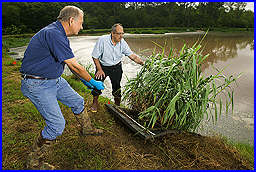



Floating Plant Mats Help Clean Manure Lagoons
US - Studies have shown that it’s possible to remove excess nutrients from manure lagoons by growing plants on floating mats. Agricultural Research Service (ARS) scientists in Tifton, Ga., have been studying how to most efficiently use this method to extract excess nitrogen and phosphorus from wastewater so it won’t become an environmental problem. |
| Giant reed, which has shown the greatest biomass production potential for floating platforms on wastewater lagoons, is examined by technician Bobby Shiver (left) and soil scientist Robert Hubbard just before harvesting. |
Soil scientist Robert Hubbard, in the ARS Southeast Watershed Research Unit at Tifton; plant pathologist Jeffrey Wilson and geneticist William Anderson at the ARS Crop Genetics and Breeding Research Unit in Tifton; and colleagues Larry Newton, John Ruter and Gary Gascho at the University of Georgia are trying to determine the feasibility of removing excess nutrients in this way.
Lagoons are commonly used to store wastewater from confined-feeding dairy and swine operations. The nutrient-laden water is generally applied to land as fertilizer. But if it’s not applied properly, any excess nitrogen and phosphorus may eventually contaminate drinking water, impair soil quality and cause “dead zones” in surface waters.
One research phase has been completed and a second is under way. The first phase was conducted in small tanks, the mats tested on full-strength wastewater, half-strength wastewater, or an inorganic solution. Vegetation was grown atop floating rafts constructed of PVC pipe and chicken wire that was covered with jute erosion-control matting.
In that phase, cattail grew the best on full-strength wastewater, produced the most biomass, and removed the most nutrients. Studies showed that harvesting cattail from the floating rafts could remove an average of 493 grams of nitrogen and 73 grams of phosphorus per square meter per year.
Now the second phase of research is being conducted at Southern Select Farms, a commercial hog farm in Tifton that has a single anaerobic lagoon. A new type of floating mat, consisting of plastic foam covered with braided coir--the coarse fibers from the outer shell of coconuts--will be tested. It was designed in cooperation with Maryland and Charleston Aquatic Nurseries, located in Jarretsville, Maryland, and Johns Island, South Carolina, respectively.
Several different plant species seem to be good candidates, including St. Augustine grass, coastal Bermudagrass, and giant reed, which have potential as a source of bioenergy fuel.
ThePoultrySite News Desk








